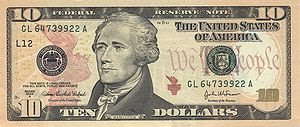
Ask someone whose portrait is on the ten dollar bill and you will probably get an answer like Abraham Lincoln or Benjamin Franklin. In fact, it is Alexander Hamilton, first United States Secretary of the Treasury and a Founding Father of our country. Hamilton even lead three battalions of troops at the Battle of Yorktown.
Hamilton believed in a strong central government as well as industry and trade as the basis for a vital country. One of the ideas that he championed was the formation of the first public-private corporation in the United States. The Society for the Establishment of Useful Manufactures (or SUM) received a corporate charter from the New Jersey legislature in 1791. A survey of possible waterpower-driven manufacturing locations identified the Great Falls of the Passaic River in New Jersey as the best site to build the new enterprise.

To provide a place for the working people to live, the town of Paterson, NJ was founded next to the falls. It was named after William Paterson, governor of the state -- a wise political move to help build support. Some of the charter members wanted to name the town after Hamilton but he would have none of it. In fact, Hamilton would not participate financially in order to avoid a conflict of interest, even though he had championed the idea. The corporate charter allowed for a subscription of up to a million dollars in capital, a huge undertaking for that time. Leading business men subscribed to the stock and the first factories were built and put into operation to produce textiles. Other products planned included iron wire and even straw hats.
Paterson was the first planned industrial community in the United States. The original plan for the town was proposed by Pierre L'Enfant, the same architect who laid out the plans for Washington, D.C. L'Enfant was soon replaced, however, as his plans were viewed as much too grandiose for the needs of the industrial town. A much more pragmatic plan was undertaken to guide the building of the new town.
Alas, all did not go well. The first head of the SUM corporation embezzled much of the money. The mills never became profitable due to small manufacturing volumes and extended start-up costs. The waterpower capability of the falls was over-estimated. And mismanagement fouled up much of the remainder. By 1796, the project was closed down and Paterson became a virtual ghost town.
But all did not end there. As the technology matured, new factories were opened on the Passaic by independent businessmen who leased the water rights from the Society. The Society actually turned a tidy profit on its real estate and water rights deals. Paterson was even the first site for Samuel Colt's manufacturing of firearms in 1835 (although Colt later moved his business to Connecticut). Paterson continued to prosper through the next 150 years as a manufacturing center.
The story has a tragic ending for Hamilton as well. In July of 1804, Hamilton was mortally wounded in a duel with the Vice President, Aaron Burr. Burr had taken offense at a supposed derisive comment Hamilton had made about Burr and demanded a pistol duel. Evidence suggests that Hamilton deliberately missed Burr but Burr had every intention of killing Hamilton who was shot in the lower abdomen. Burr was charged with murder but never tried. He fled to South Carolina but later returned to Washington, D.C. to complete his term as Vice President.
American Experience on PBS has a great biography of Hamilton which you can watch online here.
No comments:
Post a Comment